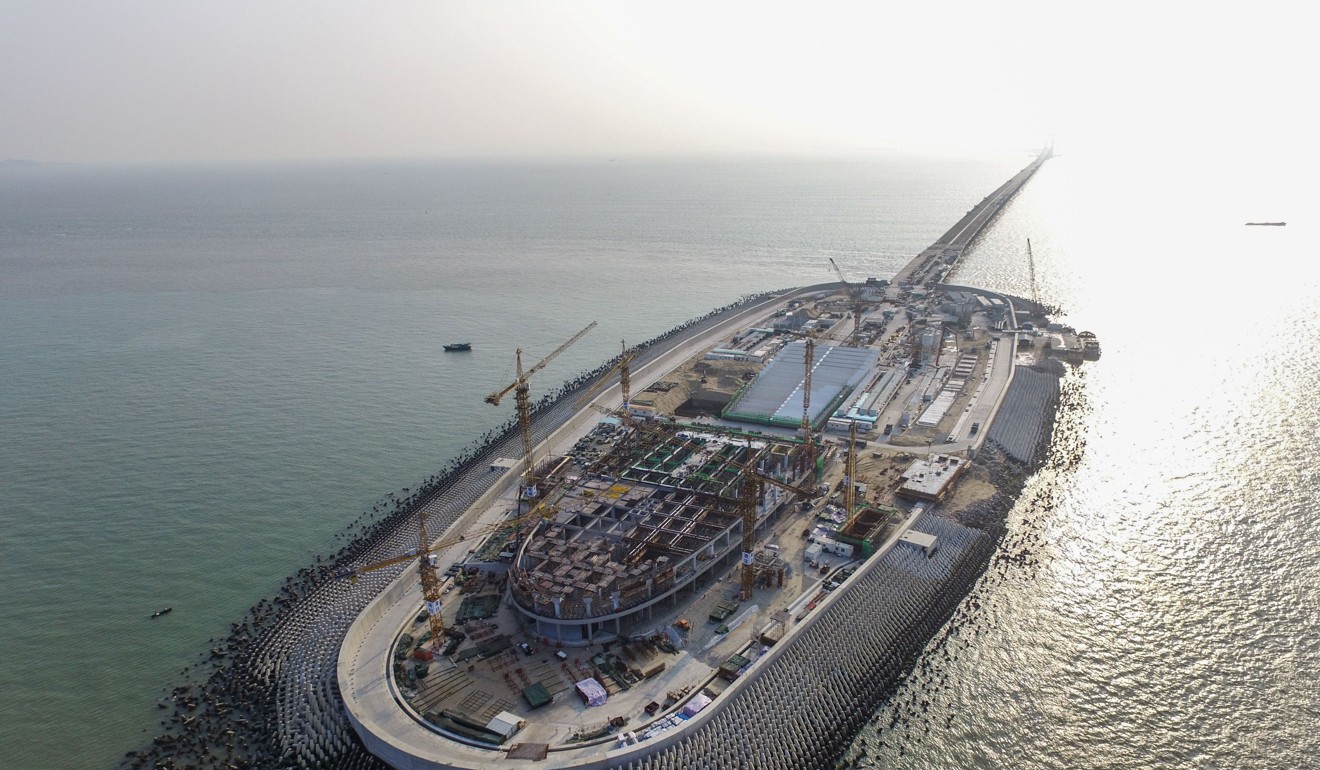
Is Hong Kong’s giant bridge a road to nowhere or path to new opportunities?
Some say the 35km link to Macau and Zhuhai will bring great economic benefits; others fear it’s a white elephant
It was déjà vu for the government as officials had received the same news in February when they visited the artificial island off Chek Lap Kok that will house Hong Kong’s immigration and customs facilities.

This meant the three governments involved in the project – Hong Kong, Macau and Guangdong – would need to chip in additional funds on a proportional basis.
Financing comprised two key parts – cash contributions totaling 15.73 billion yuan (HK$18 billion) from the three governments with the Hong Kong government paying 6.75 billion yuan, plus a syndicated loan of 22 billion yuan from financial institutions. The loan would be repaid using income generated by the bridge after it opens at a date yet to be fixed.
Watch: Xi Jinping inspects the Hong Kong-Zhuhai-Macau Bridge
But the latest cost overrun was not the last controversy to hit the bridge.
Since construction began on the Hong Kong section in 2011, 10 workers have died and more than 600 have been injured in 275 incidents.
But what really dealt a blow to the project was a corruption scandal in which staff of a laboratory contractor were accused of faking concrete test results and switching samples so tests could be approved.

Given all these scandals, it is no surprise that people are asking whether Hong Kong has taken on a project that is too big for it to handle – a development that was meant to bring closer economic integration between Hong Kong and the western side of the Pearl River Delta through enhanced labour and goods flows.
Some critics have branded the project a big “white elephant” or a “black hole” that is set to become a fiscal abyss, while others are upbeat about its future as it will open a whole new world to Hongkongers.
The sole purpose of this bridge was to cater to the development needs of the mainland
Civil engineer Albert Lai Kwong-tak, convener of think tank Professional Commons, is one of the pessimists. He said the safety scandals resulted from political considerations overriding professional judgments with regard to the design and construction of the bridge.
“The sole purpose of this bridge was to cater to the development needs of the mainland. As a result, all professional considerations such as its design have not been fully taken into account,” he argued.
The 35.6km bridge and tunnel will link northern Lantau across the Pearl River estuary to Zhuhai and Macau in the west.

In 2009, the government projected daily traffic flow across the bridge could reach 11,600 to 16,550 vehicles on opening, and 42,450 to 57,300 per day by 2035.
It also envisaged tolls could be set at a lower range such as 100 yuan for private cars and 200 yuan for trucks. But the exact toll levels will be decided by the three governments nearer the time of the bridge’s opening based on the latest estimated operating costs, traffic volume and other factors.
“The bridge is going against Hong Kong’s transport aspiration. It defies logic that the government didn’t adopt the option of building a rail link, which is more transport friendly and cost-efficient,” Lai said.
A rail option was never considered after Hopewell Holdings founder Gordon Wu Ying-sheung championed a bridge with private sector participation back in the 1980s. A rail project would have to involve mainland state-owned companies.

However, Lai accused the Hong Kong government of compromising safety standards in order to meet the completion target.
“There have been a lot of cover-ups by the government, reflecting the fact that it has done a poor job in monitoring the project,” he said.
“Under the current governance system, officials can avoid being held accountable for policy blunders because they have the iron votes of the pro-establishment camp in the Legislative Council to fend off any fault-finding investigations. This mindset has caused them to become lax in supervision and overlook many irregularities.
“I am afraid with all these safety scandals, in the end this bridge will become a thing of no value as no vehicles will dare to travel across it.”

“Time is of the essence. This is a national project and all parties are eyeing time management,” he said. “All the past incidents have something to do with meeting deadlines. They happened because some people needed to rush the project to complete it on time.”
The lawmaker was particularly opposed to the current tender system as it ignored whether firms had breached industrial regulations.
“This tendering system only considers the bidding price and the time schedule. But the bidders’ records on safety regulations are never a factor in the assessment process. I think those with poor records should have some points deducted,” he said.
Tien said in the past the government would hire a consultant to deliver a building design plan for contractors to follow. “But to save time, the government this time contracted out the building design so it could apply for Legco funding just once.”
As long as Hong Kong and the mainland continue to develop, there will be economic returns from the bridge
The downside was that some contractors might adopt risky procedures to meet targets, he said, citing as an example the use of a non-dredging reclamation method which caused the drifting of the artificial island.
The non-dredging technique, a more environmentally friendly form of reclamation being used in the city for the first time, involved the sinking of huge steel cells into the seabed. They were then filled with debris, eliminating the need for dredging.
Lai pointed out the non-dredging method was riskier as it would impose greater pressure on the seawalls, causing movement. “But it shortened the time for reclamation and also helped the project pass required environmental assessments,” he said.
“Ironically, everything has backfired. The supposedly time-saving construction method ends up slowing down the whole project.”
Lai also warned that the island’s maintenance cost would be astronomical as the island, which was not given enough time to settle, would gradually sink over a long period of time.
“Though the subsidence of the island won’t pose any safety risks, its maintenance cost will be huge because the consolidation method will be very technical and costly,” he said.
The latest government figures show the number of cross-boundary private cars and goods vehicles stands at around 29,600 and 12,900 respectively. The number of cross-border buses and hire cars is 1,200 and 400.
The bridge linking Shenzhen and Zhongshan, which is expected to be completed by 2024, will shorten travel time between the two cities from two hours to 20 minutes.
“This is a growing big white elephant, a huge liability for Hong Kong people,” Lai concluded.
Citing the views of Dr Tan Tieniu, deputy director of Beijing’s liaison office in Hong Kong, Tien said the Greater Bay Area would serve as an innovation technology hub.
“This will create a lot of high-skilled opportunities for Hongkongers that they cannot find in Hong Kong. The bridge will enable them to go to work on the mainland every morning and return to Hong Kong every night. It’s like going to Yuen Long for work,” he said.
To facilitate bridge usage, Tien suggested that the three governments provide parking spaces at their respective checkpoints to allow people to park there without having to apply for special permits.
Former transport minister Anthony Cheung also dismissed the suggestion that the road link would be a while elephant. “This is not how I view the bridge. As long as Hong Kong and the mainland continue to develop, there will be economic returns from the bridge,” he said.
TIMELINE FOR THE BIG BRIDGE
1983: Hopewell Holdings founder Gordon Wu proposes idea of a bridge across the Pearl River estuary
1989: Zhuhai government publishes proposal for a Lingdingyang bridge
1997: Central government expresses support for Lingdingyang bridge
2003: Hong Kong-Zhuhai-Macau Bridge Advance Work Coordination Group established
2007: Task force led by National Development and Reform Commission set up by State Council; seabed feasibility study begins
2008: Governments of Guangdong, Hong Kong and Macau agree to finance 42 per cent of costs. Remaining 58 per cent will come from Bank of China loans totalling 22 billion yuan
2009: Three governments sign contract for preliminary design of main body of bridge. Main bridge construction starts
2011: After a delay of over one year caused by a judicial review, construction begins on Hong Kong section
2012: Legislative Council approves extra HK$8.8 billion in construction costs arising from delay
2015: Government admits movement of up to seven metres in the artificial island. It later announces one-year delay until the end of 2017 due to technical challenges, unstable material supplies and labour shortage.
2016: Extra funding of HK$5.4 billion sought from lawmakers. Officials later admit drifting of te artificial island was more serious than thought as there had been movement of up to seven metres at 22 locations. In November, government announces delay to Tuen Mun-Chek Lap Kok Link.
2017: Two seawalls on reclaimed land collapse over two years ago due to irregular extensions. Tuen Mun-Chek Lap Lok link further delayed beyond 2020 as a contractor fails to deliver revised design plan. In March, two workers are killed and three injured in a bridge accident. In May, graft-busters arrested 21 employees of a contractor for allegedly faking concrete test results

